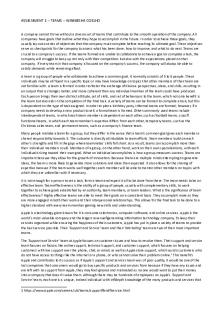MAN unit 9 assignment - A. Reddin 3-D Leadership Model PDF

| Title | MAN unit 9 assignment - A. Reddin 3-D Leadership Model |
|---|---|
| Author | alissia saquer |
| Course | Introduction To Management |
| Institution | Broward College |
| Pages | 2 |
| File Size | 99 KB |
| File Type | |
| Total Downloads | 16 |
| Total Views | 142 |
Summary
A. Reddin 3-D Leadership Model...
Description
Alissia Saquer MAN2021 Maggy Smith Due June 7th, 2020 Assignment: Unit 9
A. Reddin 3-D Leadership Model To briefly describe Reddin’s 3-D Leadership Model, it was first presented by professor Bill Reddin, hence the name. Reddin created a concept called “situational demands” this concept dives deep to explain ways in which the leader must behave to be most successful. Reddin’s model was based of the two static dimensions of leadership, he called them task orientation and relationships orientation. However, he then presented a third dimension called Effectiveness. Effectiveness to put it shortly is what derived when an individual used the correct style of leadership for a specific situation.
B. Blake and Mouton’s Managerial Grid Blake and Mouton’s managerial grid is an interesting and well-developed concept, their model originally recognized five separate leadership techniques based on worry for personnel and production. Interesting enough these optimal leadership styles are actively based on Theory Y. The five different leadership techniques are split up between impoverished, country club, produce or parish, middle of the room and team leader. Finally, to explore how leadership is determined by a manager is simple, they use the two dimensions given by the grid which is concern for production and concern for people. To further explain, when using these two dimensions they use the grid and the five separate techniques to then find a perfect match. C. Likerts Systems of Management There are many management systems, but I feel Likert’s system is especially absorbing. Likert’s Management System was developed by Rensis Likert in the 1960s. Likert created an amazing concept that outlined four different systems of management, these include: Exploitative Authoritative, Benevolent Authoritative, Consultative and Participative. In depth Likert’s view was fairly simple, the closer the organizational attributes are to the Participative system, the more contented and therefore more productive the workplace personnel will be. There are several key concepts in which all around shape the basis of this management system, notably: Motivation, Leadership, Communication, Influence and decision making, all these key concepts and attributes is what helps form the system as a whole. D. Tannenbaum and Schmidt Continuum Theory Tannenbaum and Schmidt Continuum model is a theory in which it directly coincides with Theory X/Y. The basis of this model shows the association between the quantity of privilege that
a manager decides to approve to a team, and the level of dominance used by the manager. As a further explanation, the team's privilege expands, the manager's dominance is reduced. This is a constructive impact for both teams and a healthy and fruitful way for managers to progress. Unlike other theories and management models Tannenbaum and Schmidt’s Continuum only relies on two basic leadership styles correlated with the situational leadership, these include: leader's personality and the perceived qualities of subordinates.
Sources Alig-Mielcarek, J. M., & Hoy, W. K. (2005). Instructional leadership: Its nature, meaning, and influence. In C. G. Miskel & W. K. Hoy (Eds.), Educational leadership and reform (pp. 29–54). Greenwich, CT: Information Age Publishing. Bass, B. M. (1999). Two decades of research and development in transformational leadership. European Journal of Work and Organizational Psychology, 8(1), 9–32 Burns, J. M. (1990). Reddin Leadership. New York: Harper & Row. Jennifer, L. H. (2005). Blake and Mouton. International Journal of Intercultural relations. Gadermann, Anne M., Guhn, Martin & Bruno D. Zumbo (2012). Estimating ordinal reliability for Likert-type and ordinal item response data: A conceptual, empirical, and practical guide. Practical Assessment, Research & Evaluation, 17 Russ, T.L. (2011), "Theory X/Y assumptions as predictors of managers' propensity for participative decision making", Management Decision,...
Similar Free PDFs

KIPP Leadership Competency Model
- 10 Pages

Contingency Model of Leadership
- 2 Pages

Personal Model of Leadership
- 4 Pages

Co-Leadership Model
- 15 Pages

Assignment 11 - Unit 9 Exercise
- 3 Pages

Leadership Assignment
- 4 Pages

Assignment 2 - Demolition Man
- 9 Pages

Chapter 9 Leadership Communication
- 24 Pages
Popular Institutions
- Tinajero National High School - Annex
- Politeknik Caltex Riau
- Yokohama City University
- SGT University
- University of Al-Qadisiyah
- Divine Word College of Vigan
- Techniek College Rotterdam
- Universidade de Santiago
- Universiti Teknologi MARA Cawangan Johor Kampus Pasir Gudang
- Poltekkes Kemenkes Yogyakarta
- Baguio City National High School
- Colegio san marcos
- preparatoria uno
- Centro de Bachillerato Tecnológico Industrial y de Servicios No. 107
- Dalian Maritime University
- Quang Trung Secondary School
- Colegio Tecnológico en Informática
- Corporación Regional de Educación Superior
- Grupo CEDVA
- Dar Al Uloom University
- Centro de Estudios Preuniversitarios de la Universidad Nacional de Ingeniería
- 上智大学
- Aakash International School, Nuna Majara
- San Felipe Neri Catholic School
- Kang Chiao International School - New Taipei City
- Misamis Occidental National High School
- Institución Educativa Escuela Normal Juan Ladrilleros
- Kolehiyo ng Pantukan
- Batanes State College
- Instituto Continental
- Sekolah Menengah Kejuruan Kesehatan Kaltara (Tarakan)
- Colegio de La Inmaculada Concepcion - Cebu







